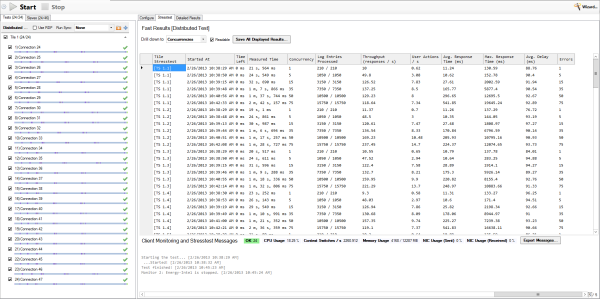Calxeda's ARM server tested
by Johan De Gelas on March 12, 2013 7:14 PM EST- Posted in
- IT Computing
- Arm
- Xeon
- Boston
- Calxeda
- server
- Enterprise CPUs
Our Real World Test
We've set up two systems, the Xeon system with two different pairs of Xeon CPUs, 128GB and ESXi 5.1. We created 24 virtual machines on top of the Xeon server. Inside each we have a PhpBB (Apache2, MySQL) website with four virtual CPUs and 4GB RAM. The website uses about 8GB of disk space. We simulate up to 75 concurrent users that send new requests every 0.6-2.4 seconds.
The Boston Viridis server gets the same workload, but instead of using virtual machines, we used the 24 physical server nodes.
Since the redesign in late 2010, our vApus stresstesting framework is well suited to hit (virtualized or not) clusters with lots of workloads in parallel. A quad 7400 server is able to spawn 24 testing clients. The server is connected to our Dell PowerConnect 8024F (10Gbit Ethernet), which is connected to the testservers.
vApus hitting 24 web servers in parallel
This way we can simulate a webhosting environment where tens of websites are hit by a few thousands of visitors per second. That might not sound very impressive, but those few thousand requests per second result in a web environment with 100 million hits per day.
Since we made sure that our web server serves up some nice pictures (png), there is some significant network traffic going on. We measured peaks of up to 8Gbit/s, with typical network traffic being about 4 to 6Gbit/s.











99 Comments
View All Comments
kfreund - Friday, March 15, 2013 - link
Keep in mind that this is VERY early in the life cycle, and therefore costs are artificially high due to low volumes. Ramp up the volumes, and the prices will come WAY down.wsw1982 - Wednesday, April 3, 2013 - link
Ja, IF they have high volume. But even if there is high volume, it's shared between different ARM suppliers and needless to say, the ATOM. How much can it be for one company?But the question is where the ARM get the volume? less performance, comparable power consumption, less performance/watt rational (not this kind extreme bias case ), less flexibility, less software support (stability), vendor specific (you can build a normal server, but can you build up a massive parallel cluster?), oh, don't forgot, more (much more) expensive. Which company will sacrifice themselves to beef up the market volume of the ARM server?
Sputnik_b - Thursday, March 14, 2013 - link
Hi Johan,Nice job benchmarking and analyzing the results. Our group at EPFL has recently done some work aimed at understanding the demands that scale-out workloads, such as web serving, place on processor architectures. Our findings very much agree with your benchmark conclusions for the Xeon/Calxeda pair. However, a key result of our work was that many-core processors (with dozens of simple cores per chip) are the sweet spot with regard to performance per TCO dollar. I encourage you to take a look at our work -- http://parsa.epfl.ch/~grot/pubs/SOP-TCO_IEEEMicro....
Please consider benchmarking a Tilera system to round-out your evaluation.
Best regards!
Sputnik_b - Thursday, March 14, 2013 - link
Sorry, bad URL in the post above. This should work: http://parsa.epfl.ch/~grot/pubs/SOP-TCO_IEEEMicro....aryonoco - Friday, March 15, 2013 - link
LWN.net has a very interesting write-up on a talk given by Facebook's Director of Capacity Engineering & Analysis on the future of ARM servers and how they see ARM servers fit in with their operation. I think it gives valuable insight on this topic.http://lwn.net/SubscriberLink/542518/bb5d5d3498359... (free link)
phoenix_rizzen - Friday, March 15, 2013 - link
ARM already has hardware virtualisation extensions. Linux-KVM has already been ported over to support it.Andys - Saturday, March 16, 2013 - link
Great article, finally good to see some realistic benchmarks run on the new ARM platform.But I feel that you screwed up in one regard: You should have tested the top Xoen CPU also - the E5-2690.
As you know from your own previous articles, Intel's top CPUs are also the most power efficient under full load, and the price would still be cheaper than the full loaded Calxeda box anyway.
an3000 - Monday, March 25, 2013 - link
It is a test using wrong software stack. Yes, I am not afraid to say that! Apache will never be used on such ARM servers. They are exact match for Memcached or Nginx or another set-get type services, like static data serving. Using Apache or LAMP stack is too much favorable for Xeon.What I would like to see is: Xeon server with max RAM non-virtualized running 4-8 (similar to core count) instances of Memcached/Nginx/lighttpd vs cluster of ARM cores doing the same light task. Measure performance and power usage.
wsw1982 - Wednesday, April 3, 2013 - link
My suggestion will be let them run one hard-disk to one hard-disk copy and measure the power usage:)